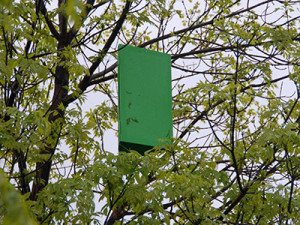
BOULDER, Colo. – This week, the Colorado State Forest Service is partnering with Boulder County and the City of Boulder to place more than 65 traps targeting the tree-killing emerald ash borer (EAB).
Not actually intended to contain the pest population, the devices instead are being deployed to research the most effective trapping methods for the destructive pest and to try and detect its presence along roadways just outside the city.
To date, EAB has only been detected within the Boulder city limits, but has become a concern all over the state, as an estimated 15 percent or more of all urban and community trees here are ash (genus Fraxinus).
“We’re hoping to determine if the emerald ash borer is outside of the presently known infested area, by focusing on high-traffic travel corridors,” said Dan West, CSFS forest entomologist and member of the interagency Colorado EAB Response Team*.
West says studies have shown that high-volume vehicle corridors are a pathway for the human-assisted spread of EAB through the movement of infested wood material. EAB, a non-native pest responsible for the death of tens of millions of ash trees in the United States, can fly up to a half-mile to infest new trees – but can spread much farther when people transport firewood and other raw wood.
The CSFS is placing the purple and green traps in tree canopies to meet two objectives: to try and determine if the pest is spreading farther than has been confirmed to date and to compare the effectiveness of different trapping methods. Traps are being strategically placed near high-traffic roads on county properties and rights-of-way leading out of Boulder, including State Highway 7 and South Boulder Road, to seek initial detection. Other traps have been set within known infested areas of the city under various configurations, to help improve detection methods and increase future trapping success rates.
“Trapping efforts by the Colorado State Forest Service are helping Boulder County and the City of Boulder detect EAB in new areas throughout the county, and continued collaboration may lead to methods for earlier detection,” said Brett Stadsvold, EAB coordinator for Boulder County.
These trapping efforts are part of a larger interagency EAB Response Team effort to help manage the spread and impacts of the pest in Colorado, and complement a national EAB survey led annually by the USDA Animal and Plant Health Inspection Service.
West says the team is hoping to have all of the Boulder-area traps out by the end of this week; after that, the traps will be checked every two weeks until the end of the EAB flight season in early fall, when the traps will be removed.
For more information about ash tree identification, the symptoms of EAB and treatment options, as well as an updated map showing where EAB has been detected in Colorado, go to www.eabcolorado.com.
For additional information, please read the CSFS Emerald Ash Borer Quick Guide.
*The Colorado EAB Response Team is comprised of members from the following agencies/organizations: Boulder County, City of Boulder, Colorado Department of Agriculture, Colorado State Forest Service, Colorado State University Extension, Colorado Tree Coalition, Green Industries of Colorado, University of Colorado and USDA Animal and Plant Health Inspection Service.

